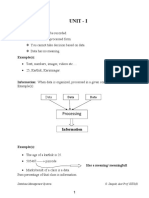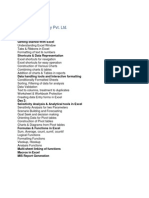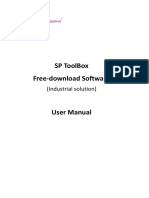0 ratings0% found this document useful (0 votes)
26 viewsProgramming Assignment Unit 5 Solution v2
This document discusses the SQL statements used to create 8 tables for a medical database: Specialty, Doctor, Patient, Allergy, PatientAllergy, Appointment, Medicine, and PatientMedicine. It explains that constraints can be defined directly in a Create Table statement or by altering an existing table. It also notes that some databases use separate date and time data types while others allow them to be used together.
Uploaded by
Everything PromoCopyright
© © All Rights Reserved
Available Formats
Download as PDF, TXT or read online on Scribd
0 ratings0% found this document useful (0 votes)
26 viewsProgramming Assignment Unit 5 Solution v2
This document discusses the SQL statements used to create 8 tables for a medical database: Specialty, Doctor, Patient, Allergy, PatientAllergy, Appointment, Medicine, and PatientMedicine. It explains that constraints can be defined directly in a Create Table statement or by altering an existing table. It also notes that some databases use separate date and time data types while others allow them to be used together.
Uploaded by
Everything PromoCopyright
© © All Rights Reserved
Available Formats
Download as PDF, TXT or read online on Scribd
You are on page 1/ 3
Programming
Assignment Unit 5 – Solution
The following SQL statements are used to create the Specialty, Doctor, Patient, Allergy, PatientAllergy,
Appointment, Medicine, and PatientMedicine tables.
As you can see Not Null constraints are added using the “Not Null” clause. We can define constraints in
two ways:
1) A constraint can directly be defined in Create Table statement.
2) A constraint can be defined by altering an existing table with a constraint as in altering Doctor
Table.
Using dates and times could be confusing in SQL. IBM DB2 and OpenOffice BASE use “date” and “time”
data types separately. However, date and time could be used together with Oracle and Microsoft SQL
Server.
Specialty Table
Create Table Specialty(
SpecialtyNumber char(10) Not Null,
SpecialtyName char (40),
CONSTRAINT pk_sn PRIMARY KEY (SpecialtyNumber),
CONSTRAINT uq_sn Unique (SpecialtyNumber)
);
Doctor Table
Create Table Doctor(
DoctorID char(10) Not Null,
Name char (40) Not Null,
Phone char (20) Not Null,
SpecialtyNumber char(10) Not Null,
Supervisor char(10),
CONSTRAINT pk_did PRIMARY KEY (DoctorID),
CONSTRAINT uq_did Unique (DoctorID)
);
ALTER TABLE Doctor
ADD CONSTRAINT fk_Specialty FOREIGN KEY (SpecialtyNumber)
REFERENCES Specialty(SpecialtyNumber);
Patient Table
Create Table Patient(
PatientID char(10) Not Null,
Name char(40) Not Null,
Phone char(20) Not Null,
Email char(40),
Address char(100) Not Null,
AddedDate date Not Null,
DoctorID char(10) Not Null,
CONSTRAINT pk_pid PRIMARY KEY (PatientID),
CONSTRAINT uq_pid Unique (PatientID),
CONSTRAINT fk_doctor FOREIGN KEY (DoctorID) REFERENCES Doctor(DoctorID)
);
Allergy Table
Create Table Allergy(
AllergyID char(10) Not Null,
AllergyName char(40) Not Null,
CONSTRAINT pk_aid PRIMARY KEY (AllergyID),
CONSTRAINT uq_aid Unique (AllergyID)
);
PatientAllergy Table
Create Table PatientAllergy(
AllergyID char(10) Not Null,
PatientID char(10) Not Null,
CONSTRAINT pk_apid PRIMARY KEY (AllergyID,PatientID),
CONSTRAINT uq_apid Unique (AllergyID,PatientID),
CONSTRAINT fk_allergy FOREIGN KEY (AllergyID) REFERENCES Allergy(AllergyID),
CONSTRAINT fk_patient FOREIGN KEY (PatientID) REFERENCES Patient(PatientID)
);
Appointment Table
Create Table Appointment(
AppointmentID char(10) Not Null,
PatientID char(10) Not Null,
DoctorID char(10) Not Null,
AppointmentDate date Not Null,
BloodPressure smallint Not Null,
Weight decimal(5,2) Not Null,
TreatmentNotes char(255) Not Null,
CONSTRAINT pk_appid PRIMARY KEY (AppointmentID),
CONSTRAINT uq_appid Unique (AppointmentID),
CONSTRAINT fk_doctor_app FOREIGN KEY (DoctorID) REFERENCES Doctor(DoctorID),
CONSTRAINT fk_patient_app FOREIGN KEY (PatientID) REFERENCES Patient(PatientID)
);
Medicine Table
Create Table Medicine(
MedicineID char(10) Not Null,
MedicineName char (40) Not Null,
CONSTRAINT pk_mid_pk PRIMARY KEY (MedicineID),
CONSTRAINT uq_mid Unique (MedicineID)
);
PatientMedicine Table
Create Table PatientMedicine(
AppointmentID char(10) Not Null,
MedicineID char(10) Not Null,
CONSTRAINT pk_pmid PRIMARY KEY (AppointmentID,MedicineID),
CONSTRAINT uq_pmid Unique (AppointmentID,MedicineID),
CONSTRAINT fk_appointment FOREIGN KEY (AppointmentID) REFERENCES
Appointment(AppointmentID),
CONSTRAINT fk_medicine FOREIGN KEY (MedicineID) REFERENCES Medicine(MedicineID)
);
You might also like
- Programming Assignment Unit 7 Solution v1No ratings yetProgramming Assignment Unit 7 Solution v112 pages
- Project Report: Dbms Project On Hospital Management SystemNo ratings yetProject Report: Dbms Project On Hospital Management System34 pages
- Appendix B: 1. Commands Used To Create SchemaNo ratings yetAppendix B: 1. Commands Used To Create Schema8 pages
- Hospital Mangment System: Database AssigmentNo ratings yetHospital Mangment System: Database Assigment4 pages
- Fields Data Type Relationships: PatientNo ratings yetFields Data Type Relationships: Patient12 pages
- Project Name Docmate: Ahsanullah University of Science & TechnologyNo ratings yetProject Name Docmate: Ahsanullah University of Science & Technology9 pages
- Table 1 Data Dictionary For Activity - LogNo ratings yetTable 1 Data Dictionary For Activity - Log9 pages
- Analyzing and Designing Hospital DatabaseNo ratings yetAnalyzing and Designing Hospital Database8 pages
- Clinic Management System Database SchemaNo ratings yetClinic Management System Database Schema3 pages
- Entity Relationship Diagram: Doctor PatientNo ratings yetEntity Relationship Diagram: Doctor Patient1 page
- SQL Exercises - Scientists - Wikibooks, Open Books For An Open WorldNo ratings yetSQL Exercises - Scientists - Wikibooks, Open Books For An Open World4 pages
- Management Memory - SQL - WinCC Tag Logging and Alarm Logging - WebNo ratings yetManagement Memory - SQL - WinCC Tag Logging and Alarm Logging - Web2 pages
- Understanding BW Non Cumulative Concept As Applicable in Inventory Management Data ModelNo ratings yetUnderstanding BW Non Cumulative Concept As Applicable in Inventory Management Data Model14 pages
- Pentaho Data Integration (PDI) TutorialNo ratings yetPentaho Data Integration (PDI) Tutorial33 pages
- Introduction To Linux I Chapter 19 Exam AnswerNo ratings yetIntroduction To Linux I Chapter 19 Exam Answer5 pages
- SP SSD Toolbox Industrial User Manual v1 0 - EN - 170110No ratings yetSP SSD Toolbox Industrial User Manual v1 0 - EN - 17011016 pages
- The Accounting Review Jan 1990 65, 1 Proquest CentralNo ratings yetThe Accounting Review Jan 1990 65, 1 Proquest Central26 pages
- Car Owner Database in Delhi - CL at 882646091250% (2)Car Owner Database in Delhi - CL at 88264609123 pages

























































































